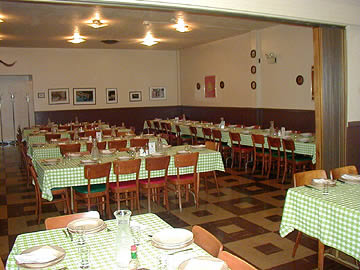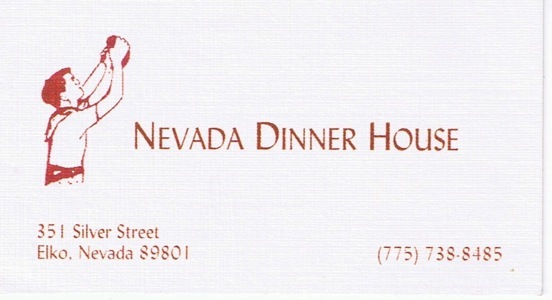Classic Roger

Big Food Nevada - Basque Style!
When last you heard from me, I promised a column relating wonders of the Silver State (Nevada that is) and not at all related to Las Vegas.
Note: This column first appeared on Jim Hill Media on February 28th, 2003.
I've mentioned previously that I have family history here that goes back to the 1860's. Something I love to make note of when dealing with newcomers like casino or hotel employees. Not that it always works, but it has on occasion.
Nevada has more to its economy than just tourism and gambling. While those do make their substantial contributions, the mining and agricultural communities have been and continue to be important as well. Contrary to popular belief, the state is not all desert sand and sagebrush. It does have water and it has been put to good use in many areas. Nevada also has considerable acreage used for open range for livestock. Wild mustangs were an issue of the Sixties (well seen in the film, "The Misfits") that brought the state to the attention of many crusaders. My great-grandfather used to round them up in his days as a vaquero for shipment east. Cattle as well benefit from the open range with a variety of good grasses across the state.
But the real story here is the world of sheep and their protectors, the Basque sheepherders.
Remember that the state is for the most part open, and has at best a sparse population. The Interstate 80 corridor -- with Reno, Sparks, Fernley, Winnemucca, Battle Mountain, Beowawe, Carlin, Elko, Wells and Wendover -- all owe their existence to the Central Pacific Railroad crossing the state. These places had water, and hence the railroad created stations at these places. Later towns sprang up at these places. Las Vegas (Okay, here is the only reference to it in the column.) was once Water Station Six on the Los Angeles, San Pedro and Salt Lake Railroad.
Other communities grew along other railroads that connected to the bigger lines mentioned above. The state capitol, Carson City, owes its existence to its place along the old Mormon trail from Utah and on to California.
With all of the states open range, sheep were a natural choice for livestock to live off the land. Let's face it. Sheep eat almost anything they can find growing. If you're establishing a hardy livestock, you need men to match them and the territory. Such were the Basque who came to Nevada starting in the 1870's. Most men were single and spoke little English.
They lived a solitary life out on the range with their flocks, but they brought a rich culture to the state that lives on today.
Reno's Santa Fe Hotel offers this sample of history about the Basque immigrants:
"During the last century, many Basque immigrants from the “Pyrenees” region of Southern France and Northern Spain settled in northern Nevada. Basque boarding houses and hotels still stand as prominent and nostalgic symbols of the Basque peoples contribution to the settlement and growth of the American West. The Santa Fe Basque Hotel in Reno, Nevada promised Basque immigrants traveling to the new country a friendly meeting place, familiar language, a warm bed and a hearty Basque dinner, all within a few blocks of the train station where many immigrants first stepped foot in Nevada to join on as ranch hands and in the expansive cow and sheep country. Having served the Reno and Tahoe area for over fifty years, the Santa Fe Basque Hotel offers one of Nevada's oldest traditions in dining. We welcome you to share in the tradition of family style Basque dining at this Nevada landmark."
And the Nevada Commission on Tourism offers a great article on the Basque presence in Nevada. An excerpt from that feature:
"In the 1870s, hundreds of Basque sheepherders migrated west to the sweet promised land of Nevada. These hard-working men spent much of their time high in the remote mountains and hills attending to their grazing flocks.
It was a lonely life. Most left families and friends behind in the Basque provinces of the Pyrenees mountains or the Cantabrian coast of northwestern Spain and southwestern France. When they had a chance, many would head to the nearest town with a Basque hotel. These hotels were a second home for the sheep men, and gave the herders a place to rest, socialize and learn the latest news from home.
Along with the comfort of a bed, the sheepherders were served generous meals that usually included beef and lamb steaks, soup, crisp salad, beans, spaghetti, bread and wine, plenty of wine.
Each hotel touted its individual "culinary flair" to attract prospective boarders. Even today, every Basque restaurant boasts about the unique qualities that sets it apart from others.
Just as important as the food was the friendly and animated mealtime conversation around the long boardinghouse tables. Basque meals are still served "family style," with patrons seated side-by-side at long tables. The arrangement just about ensures that strangers become friends, and is a unique feature of the Basque dining experience.
Basque food is the fare of a hard-working people. It is simple, always fresh, and doled out in generous portions. Garlic is the seasoning of choice.
A Basque-style chateaubriand is a thick steak cooked between two thin steaks. The thin cuts of meat are then removed and the thick rare slab served. Traditionally, chateaubriand was fed to Basque athletes before they competed in strenuous sports such as Pelota (handball). Lamb is a menu perennial, and the Basque chorizo, somewhat like the Portuguese linguica, is a spicy treat.
No self-respecting Basque hotelier would think of opening his doors if there wasn't a bar on the premises. It will be a no-nonsense bar, designed for drinking and camaraderie, not to win interior design awards. No ferns, no imitation Tiffany lamps, no European street signs. Just a hardwood bar that serves simple drinks without cute names.
The specialty of every Basque bar is a Picon Punch, a deceptively mild cocktail made with grenadine, Amer Picon, brandy and soda. While it tastes harmless enough, it packs a wallop.
Another continuing tradition is that many of Nevada's Basque restaurants are part of a hotel or boardinghouse. Some still house Basque sheepherders and permanent guests. The Martin Hotel in Winnemucca boasted of a boarder who had lived there since 1926.
The Basque tradition of excellent food, warm hospitality and unique atmosphere still can be found in any of Nevada's Basque restaurants. The prices, menus, seating and setting may vary, but a meal at a Basque restaurant is guaranteed to be a pleasant experience."
Charles Schaffer of Seattle has a wonderful online list of Basque restaurants.
Here are the selections for Nevada:
In the city of Elko
Biltoki
405 Silver St.
(702) 738-9691
4:30-10 Th-Tu
Nevada Dinner House
351 Silver St.
(702) 738-8485
5-10 Tu-Sn
Star Hotel
246 Silver St.
(702) 738-9925
(702) 753-8696
11:30-2 M-F
5-9:30 M-Sa
Toki Ona
1550 Idaho St.
(702) 738-3214
6a-9:30p M-Sn
In the city of Gardnerville (18 mi. S. of Carson City on U.S. 395)
Carson Valley Country Club
1029 Riverview Dr.
(2 mi. S. of town on U.S. 395)
(702) 265-3715
6-9 M & W-F
5:30-9 Sa
5-8 Sn
J & T
1426 S. Main St.
(702) 782-2074
11:30-2 M-Sa
5:30-9 M-Sa
Overland Hotel
691 S. Main St. (U.S. 395)
(702) 782-2138
12-2 Tu-Sn
4:45-9:30 Tu-Sn
In the city of Reno
Louis' Basque Corner
301 E. 4th St.
(702) 323-7203
11-2 Tu-Sa
5-9:30 M-Sn
Santa Fe Hotel
235 N. Lake St.
(702) 323-1891
12:30-2 W-F
6-9 M-Sn
In the city of Winnemucca
Martin Hotel
W. Railroad & Melarkey
(702) 623-3197
11-2 M-F
5-9:30 M-Sn
Ormachea's Dinner House
180 Melarkey
(702) 623-3455
4:30-10 Tu-Sn
Restaurante San Fermin
485 W. Winnemucca Blvd.
(702) 625-2555
5-10 Th-Tu
Winnemucca Hotel
"Since 1863"
95 Bridge St.
(702) 623-2908
12-1 M-Sa
6:15-9 M-Sa
Out of these listings, I have enjoyed fine meals at the following:
In Elko, the Nevada Dinner House and the Star (or Western Star Hotel). In Reno, the Santa Fe Hotel (walked right by last Saturday night, and sure wished I could have stopped in, but alas time did not allow...). In Winnemucca, the Martin Hotel and Ormachea's Dinner House.
So what kind of a meal should you expect? Let me show you!
The Santa Fe Hotel has a great web page showing off the place, the menu and the food.
And more about the meals:
"Start the evening with our favorite Basque cocktail, the "picon" at the bar. The restaurant features traditional Basque fare, served in a comfortable atmosphere that encourages you to come as you are. A healthy appetite is recommended and large parties and children are always welcome. All meals are served family style and include soup, salad, beans, french fries, wine, coffee, and ice cream or hard cheese, plus your choice of an entree and side dish from several nightly selections. Entrees offered may include steak, lamb, pork, chicken and seafood dishes. Side dishes may feature sweetbreads, tongue stew, lamb stew, Santa Fe chicken, paella, oxtail stew, or many others. Also offered are traditional desserts such as Gateau Basque, bread pudding and flan."

It's one of the dining rooms at Reno's Santa Fe Hotel!
I've been forced to watch my diet thanks to a medical condition, but I will gladly admit to enjoying as number of hearty Basque meals over the years. If you get the chance, I suggest you give one a try.
Some things you should know in advance. First, bring your appetite. This is big food. Second, most meals include a glass or more of red wine. Enjoy. Third, prices tend toward the moderate, but you get what you pay for. Fourth and finally, this is not the kind of meal to bring you vegetarian friends for. Meat will be consumed in good quality and quantity.
Only once did I pass on a Basque meal, and that was breakfast after two nights of good Nevada Basque dinners. Frankly, I didn't think my digestive system was up to the challenge at that point. But, oh! I did enjoy those two meals... Here's hoping you will, too!
Thursday, March 19, 2009

